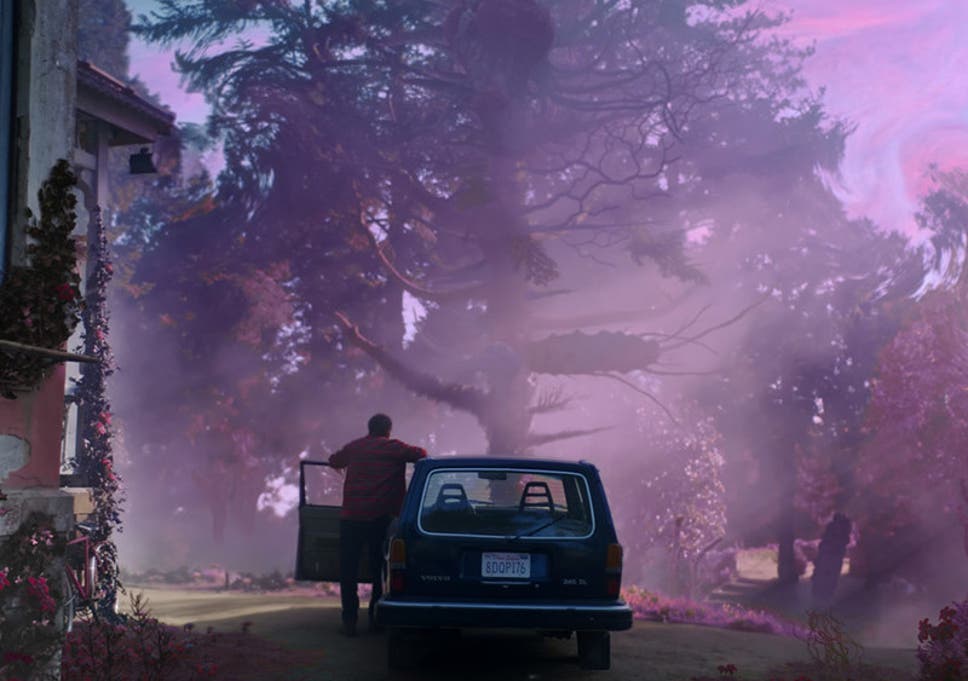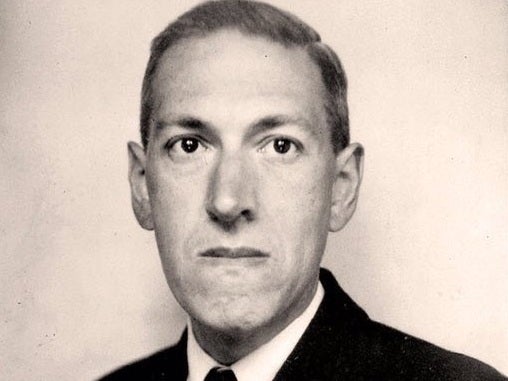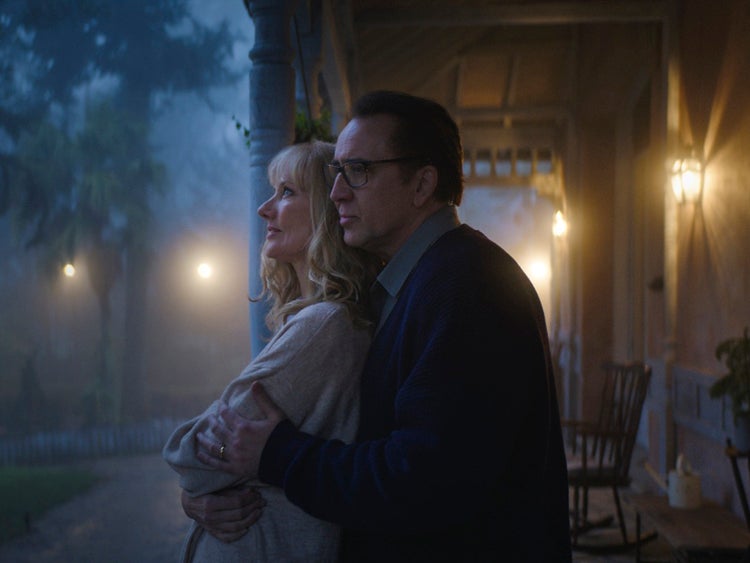Loving Lovecraft: How an obscure 1920s author became the world’s favourite horror writer
HP Lovecraft created cosmic worlds and riveting fantasy horror, before dying impoverished and obscure at the age of 46. More than 80 years later, his genius has finally been unearthed, along with his racism. As one of his books is adapted into a film starring Nicolas Cage, Ed Power explores his personal experiences as a Lovecraft devotee
Sunday 6 October 2019 08:29
13 comments

'A wretched individual whose misery somehow alchemised into fiction of lasting impact, influence and insight': Nicolas Cage in ‘Colour Out of Space’ ( XYZ Films )
Swan Point Cemetery in Providence, Rhode Island, is the most appropriate location in the world at which to suffer an onslaught of existential horror. Not that this was any comfort as I arrived there one summer, my more-than-slightly unenthusiastic girlfriend in tow, only to be confronted by rows of headstones bristling into the horizon. We had come for one grave in particular. But how to find it amid this riot of marble and faded lettering?
Our dreaded sunny day at the cemetery gates had already involved a winding drive from central Providence past the Rhode Island School of Design, where the future members of Talking Heads had met in the mid-Seventies (and where Seth MacFarlane created Family Guy).
Now came the true challenge. Swan Point is the final resting place of HP Lovecraft, father of modern horror and among the greatest pulp authors of all time (and also a racist of considerable derangement). The world is about to receive another reminder of his gibbering genius with a Nicolas Cage-starring adaptation of cosmic fright-fest Colour Out of Space, premiering at the London Film Festival on Monday.
As a fan of Lovecraft’s writing (his racism was not yet on my radar), I’d begged that we go out of our way on our holiday to visit Providence. This was our second attempt at honouring Howard Phillips. The first had come unstuck several days previously when we missed our Greyhound stop in the city centre and ended up at staring at the Cyclopean battlements of the Foxwood Casino in Connecticut (cue bonus cosmic terror). But now, finally, we’d made it.
The only problem – and this hadn’t detained us earlier because we were young and flying by our pants – was that Swan Point is vast: more than 200 acres and with some 40,000 individual plots. In America, even the baroque New England graveyards are supersized. Just then a chap wearing a uniform and driving a miniaturised tractor trundled up. He was a dead ringer for Richard Farnsworth in David Lynch’s The Straight Story. I explained that we had come with a particular purpose in mind.
“Lovecraft,” he guessed, and then we were back in the car following him as he zag-zagged through a blur of mausoleums. Not for the first time that afternoon my girlfriend and her pals, who had driven us from Boston, were throwing me funny glances. What exactly were we all doing here?
Lovecraft has been my favourite author since I was a teenager. I’d discovered him first through tabletop role-playing game Call of Cthulhu, named after one of his best-known stories (in turn named after its famous octopus-headed demigod). At Mountains of Madness and Other Stories was the first Lovecraft book I’d purchased, from my local Waterstones with money saved during a summer spent potato picking at a nearby farm.
The connection made more sense than you might imagine. The sensation of kneeling in wet potato tubers, which spatter and spray slime in the manner of an HR Giger alien egg, has stayed with me. It and my memory of At the Mountains of Madness are inextricable linked. The sensory horror of flapping about in decaying tuber is bound up with reading for the first time of the doomed Dyer expedition to Antarctica, and its run-ins with giant penguins and evil sentient pudding.
At the risk of me sounding like a Nirvana fan who insisted they never did better than Bleach, it’s fair to say that the Lovecraft industry was in its formative stages when I discovered him. Even when I visited Providence and finally came upon his grave – it was surprisingly small and overshadowed by a nearby tree into which HPL fans had etched Cthulhu-themed graffiti – his reputation was still ascending. The stars were not yet quite right.

Giant penguins and evil sentient pudding: a portrait of Lovecraft (The HP Lovecraft Estate)
Today, by contrast, Lovecraft is mega-box office. Downstairs at the Forbidden Planet flagship store in London there is a dedicated Lovecraft section. It offers not just anthology after anthology of his work but literary tributes by other writers, card games, novelty children’s books and, of course, the ubiquitous plush Cthulhu teddy bear. No other genre writer receives such VIP treatment – not Tolkien, Rowling or George RR Martin.
Lovecraft fans are, moreover, legion. One of my weirdest ever journalistic experiences was interviewing Irish actor Jack Reynor, then best known for playing a vapid hunk in Transformers: Age of Extinction.
He copped my Miskatonic University T-shirt – the name of Lovecraft’s fictional university – and gushed about his fondness for the author and how he’d always wanted to bring HPL to the screen. A few heads turned when the jock-ish Reynor fetched up in Ari Aster’s pagan horror Midsommar recently but not mine. This guy had been with the programme quite a while.
Oscar-winning director Guillermo del Toro is another member of our little funny handshake coven. He sweated blood attempting to make a $150m adaptation of At the Mountains of Madness. Tom Cruise – who, as his Oprah couch-bouncing confirmed, knows all about conjuring terrifying forces beyond our understanding – was even attached at one point. Alas, the project fell apart as the thematically similar Prometheus quasi-flopped.
But at least Del Toro’s Cthulhu credentials were beyond questioning. The amphibious romantic lead of his gong-garnering The Shape of Water (2017) was essentially a derivation of Lovecraft’s water-dwelling race of Deep Ones. And when invited to direct a Simpsons title sequence, he made sure Cthulhu – all eight eyes present and correct – featured.
Guillermo del Toro creates couch gag for The Simpsons
Nicolas Cage has now joined the club and, really, it is no surprise. He has teamed up with Richard Stanley, who made the fantastic Hardware (1990) and Dust Devil (1992) and then was famously fired from 1996 Marlon Brando dumpster fire The Island of Doctor Moreau.
Together they have updated Lovecraft’s 1927 story The Colour Out of Space for the 21st century. As in the original text, the setting is a remote farm where a mysterious asteroid has crash-landed. The borders of reality warp. Soon locals are behaving peculiarly. And then things get nasty. Once again, I’m reminded of my summer picking potatoes.
If the premise sounds familiar it is because it has been plundered on multiple occasions. Every Cold War American sci-fi film in which an isolated community is overrun by extra terrestrials bears a little of its DNA. And the recent Netflix/Alex Garland adaptation of Jeff VanderMeer’s Annihilation is essentially a big-budget homage to the Lovecraft yarn.
“It’s the story that inspired half the sci-fi movies of the 1950s,” Stanley said at a recent Q&A. “The Thing from Another World, The Blob...”
Yet the cult of Lovecraft has also brought attention to the author’s less savoury qualities. Raised in genteel poverty in Providence, he was an unabashed Anglophile who perceived himself as a British gentleman living in the wrong time and place. Unfortunately, he was under the impression that part of a British gentleman’s make-up was to be a bug-eyed xenophobe.
“A maze of hybrid squalor” is how he describes an ethnic neighbourhood of New York in his 1925 chiller The Horror at Red Hook. He writes of “Asian dregs” and the “swart, insolent” crew of a tramp steamer.
These descriptions are largely incidental. One could enjoy Red Hook with the racism expunged. Yet Lovecraft’s obsession with racial purity and the danger of tainting the blood lines is front and centre of some of his most important stories. Consider, my favourite, The Shadow over Innsmouth from 1931. It tells of an obscure New England fishing village where the locals have, through decades of miscegenation with Deep One fish-men from the South Seas, horrifically diluted their humanity.

Cosmic fright-fest: Joely Richardson and Nicolas Cage in ‘Colour Out of Space’ (XYZ Films)
Lovecraft’s evocation of a decaying fishing town is so acutely drawn you can almost smell the brine and the sea breeze. It’s a riveting read, too: the tension as the narrator clops around, gradually realising he has placed himself in terrible danger, tightens like razor wire around your neck.
Alas, the ultimate message that “superior” races must forbear from mingling with their lessers is the stuff of white supremacist fever dreams. I still love The Shadow over Innsmouth. But I’m not sure I would recommend it today.
A backlash was inevitable. The point of fracture was the World Fantasy Awards, a sort of Oscars for fantastical writing. Until 2016, the awards took the form of a bust bearing Lovecraft’s likeness. For authors of a minority background, having a HPL effigy on the shelf was understandably problematic.
“A statuette of this racist man’s head is in my home. A statuette of this racist man’s head is one of my greatest honours as a writer,” said Nigerian-American writer Nnedi Okorafor, the first black person to win the WFA for best novel. The trophy has since been redesigned: recipients of the prize no longer have to stare into the vacant visage of an author who approved of Hitler.
“The racism is a BIG problem with HPL as a person and it does pervade some of the stories,” says Julian Simpson, the writer, director and dramatist who adapted Lovecraft’s The Case of Charles Dexter Ward as an acclaimed BBC podcast last year (a follow-up retelling of Lovecraft’s The Whisperer in Darkness debuts in December).
“Sometimes it’s overt, sometimes you feel like it’s in the subtext. I didn’t worry about it with Charles Dexter Ward because it’s not really present in the story anyway and because our adaptation is sufficiently loose to be able to avoid anything that might have been a problem.”
He feared nearly everything. I read an account of him nearly fainting from the site of a fish on a platePaul Carrick
“His racism is an uncomfortable fact about him which can’t be denied and mustn’t be ignored,” adds fantasy and sci-fi writer James Lovegrove, who has made his own contribution to Lovecraftian lore by pitting Sherlock Holmes against the “mythos” in his fantastic Cthulhu Casebooks novels.
“He was a product of his times, yes, but even by those standards his views were pretty extreme. Even if we can separate the work from the man, it’s still there in the numerous references in his writings to ‘subhuman’ and ‘inferior’ races who are more susceptible than the ‘purer’ races to the gods’ evil influence. I attempted to tackle this in the second of my Cthulhu Casebooks trilogy, Sherlock Holmes and the Miskatonic Monstrosities, by having an overtly racist character get his comeuppance.
“But it’s a nettle I was extremely unwilling to grasp. We just have to accept, I feel, that Lovecraft himself was a pretty wretched individual whose misery and misanthropy somehow alchemised into fiction of lasting impact, influence and insight.”
Artist Paul Carrick, whose Lovecraftian illustrations have drawn considerable acclaim, agrees. “I cannot argue that Lovecraft did not have some racist feelings. Would I prefer it that he didn’t feel what he felt? Absolutely. Might we not have the stories as we know them if he was a model citizen of today’s standards? I bet we wouldn’t. His uncomfortable feelings were the sand in the oyster which created some incredible pearls.”
Lovecraft, as Carrick points out, wasn’t just a racist: he had all sorts of hang-ups. If there’s a phobia, he probably suffered it. “He feared nearly everything. He was afraid of change, and so immigrants were a source of change. He was afraid of the sea, which explains why so many of his creatures and alien races had aquatic elements within them. I read an account of him nearly fainting from the site of a fish on a plate.
“He more or less lived in a bubble for the first 20 or so years, and unfortunately many people born in the 1800s had racist views. I think we all like to imagine that if we were in his shoes we would act as if it were the present day, but I tend to regard this as wishful thinking.
“Fortunately, we can say that, as he got older, he started to experience more of the world and loosen his views about other races and cultures. He married a Jewish woman and also gained friends outside of his culture, both of which I would imagine was unthinkable to a younger Lovecraft.”
The World Fantasy Awards redesign has been almost universally welcomed. Ramsey Campbell, a doyen of British horror who has made his own contributions to the mythos, agrees that the feelings of authors should be respected.
“I was a judge at the first World Fantasy Awards back in 1975,” he says. “Kirby McCauley was my agent, and he was also one of the main organisers of the World Fantasy Convention, and responsible for choosing Lovecraft as the basis of the award. Since then I’ve received several, and eventually the Lifetime Award, which was in fact the last year that used Lovecraft’s image. I was and am proud to have them, not least because my old friend Gahan Wilson designed them with his typical dark humour.
“That said, I can understand why some candidates could feel offended or hurt by being considered for an award named for someone so dismissive of their race, and I wonder how I’d feel if I were one of them. On balance I think an award should give pleasure to the recipients, and so perhaps a neutral image is safer.”
Lovecraft died in 1937 at the age of 46. He was impoverished and utterly obscure. Decades would elapse before his stock would rise. One major catalyst was Sandy Petersen’s 1981 role-playing game Call of Cthulhu, which celebrated the pulpier elements of Lovecraft and cultivated a new generation of fans. Ever since, the cult has grown and grown.
“I like the fact that he’s dealing with something big and unknown and I like the mythos as an example of world-building,” says Julian Simpson. “He’s like dark Tolkien for me: a whole universe of horrors conjured from one person’s pen.”
“Lovecraft’s enduring popularity can seem strange, especially given that he had only modest literary success in his lifetime,” adds James Lovegrove. “Sometimes I think it’s a collective in-joke more than anything. People randomly alighted on a particular author who was fairly obscure and whose prose style was ungainly, to say the least, and decided to collaborate on making him posthumously famous by sharing, developing and expanding on his canon.”
But that’s a needlessly cynical view he feels. “More likely it’s the case that Lovecraft just hit on something, something universal that we all feel – a fear of unknown forces, a sense that in a world where capital-G God has lost much of His meaning and religion is used mostly for social control and fleecing its adherents, the only thing that makes sense is chaos.”
Colour Out of Space screens at the Prince Charles Cinema, Leicester Place, 7 October, 8.30pm. The Whisperer In Darkness podcast comes to BBC in December. Paul Carrick’s Lovecraft illustrations can be perused at nightserpent.com
No comments:
Post a Comment